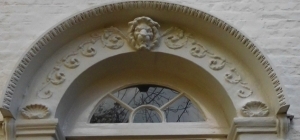A collector, a composer, and police constables
LIKE ROME, HAMPSTEAD in north London perches on several hills. A short street, Holly Walk, leads uphill from Hampstead Parish Church towards the summit of Mount Vernon, one of Hampstead’s ‘peaks’. On the southern corner of Holly Walk and the short cul-de-sac Holly Berry Lane, there stands a house, number 9 Holly Walk, that bears the name ‘The Watch House’. It was from this building, constructed in the early 19th century (c1830), that during the 1830s (1830-1834), members of Hampstead’s newly established Police Force set out on patrol and night watch. The Regency era Windsor lantern attached to the Holly Berry Lane façade is of antiquarian interest (https://historicengland.org.uk/images-books/photos/item/IOE01/15703/07). The main entrance to the building was the doorway in Holly Berry Lane; it is surmounted by a bas-relief of a lion’s head. By 1834, the police had moved to the bottom of Holly Hill opposite where the Underground Station stands now.

Next
door to the former police house with its entrance on Holly Berry Lane is a
house in which the composer Sir William Walton (1902-1983) lived in about 1939,
although I am not sure exactly when. Walton used to visit Hampstead in the 1920s
while he was composing Façade (first performed 1923), a musical setting of
poetry by Edith Sitwell (1887-1964), who was living at Greenhill, a block of
flats on Hampstead High Street. Later in life, she lived in Keats Grove.
Directly
across Holly Walk opposite the former police station, there is a large,
detached building called Moreton House. This was built in 1894-1896 in what the
architectural historian Nikolaus Pevsner describes as “… the style of a
Jacobean manor house.” The house originally had extensive terraced gardens, but
these are now covered with late 20th century houses. It was designed by Thomas Garner (1839-1906). Its
first owner was the art historian and collector Frederick E Sidney, about whom
I have discovered only a little. His
motto, which can be found in various places in Moreton House was “God is in Al
and in Al thinges”. A Fellow of the Society of Antiquaries, he was born before 1855
and died in 1932. In 1903, he published a travel book called “Anglican
innocents in Spain”. In 1937, after his death, Christies auctioned his
collection of ancient and modern pictures and drawings. The proceeds of this
sale were given to the beneficiaries of his will. Apart from the information
that he had a Torpedo model Rolls Royce Silver Ghost made for him in 1914, I
can discover little more about Mr Sidney. It seems that currently Moreton House
is divided into luxury flats.
The
three buildings I have described are within a few feet of each other. They are
close to the Catholic church on Holly Walk and the cemetery next to it. There
is so much history in such a small area, as is the case for the rest of
Hampstead. This is one of many things that endears me to the small hill town
that has been absorbed into the metropolis of London without losing too much of
its unique character.



